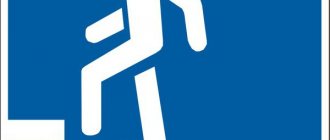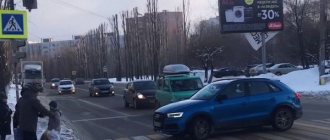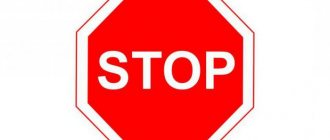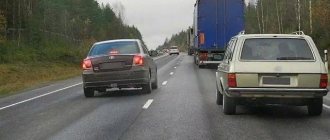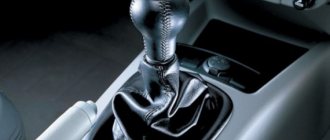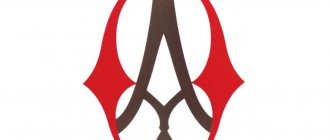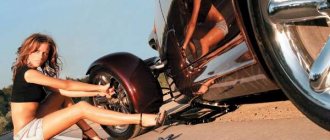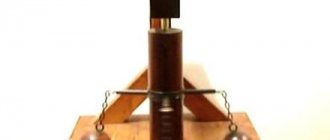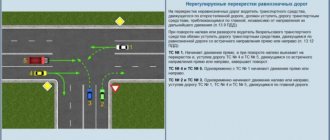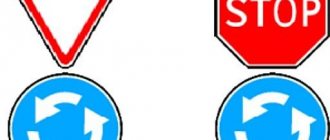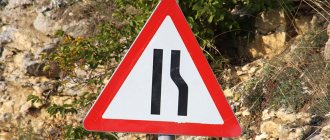Traffic priority signs are designed to establish the order of traffic at uncontrolled intersections, in places where it is impossible for two cars moving towards each other to pass simultaneously. Guided by these signs, the driver can navigate and prevent an emergency from occurring at the intersection of roadways, exiting or turning onto another road. Of course, safe traffic cannot be guaranteed if all participants, through ignorance or inattention, ignore the requirements of traffic regulations, in particular those related to priority signs. So, let’s try, avoiding formal language, to tell you a little more about this small section of the Rules.
Description of priority road signs and their meaning
Traffic priority signs, their numbers and names
The image shows priority signs made in accordance with the requirements of the standard, their names and numbers.
Road sign "Main Road" (2.1)
Installed at intersections. If you see it in front of you when approaching the intersection of roadways, then you have an advantage over cars moving from other directions. But if you need to make a left turn, then you must give way to cars moving towards you on the main road. Here it is necessary to add that the main road often changes its direction at intersections. In such cases, sign 2.1 is supplemented by plate number 8.13, which clearly informs the driver about the direction of the main road. True, there are some oddities, and the depiction of the direction of the main road on a sign can take on a rather bizarre form, thanks to the creative energy of the artist who created it. Such “masterpieces,” although not standard, still inform the driver to a sufficient extent. The coverage area of the “Main Road” sign is determined by another “End of the Main Road” sign (2.2), which is also installed at intersections.
Article on the topic: What is cruise control
"Make Way" (2.4)
A “Give Way” sign means that you are leaving a secondary road on or crossing a main road. In this case, you are obliged to give way to vehicles moving on the main road; its direction, if necessary, is also indicated using an additional sign 8.13. If, when turning left, you have to cross the path of a vehicle moving towards you straight along a secondary road, the rules establishing the passage of intersections of equivalent roadways come into force, that is, you give up the right of way to it. It should also be remembered that overtaking committed in a secondary direction while crossing the main one is punished quite severely, up to and including deprivation of your “rights” for six months.
Intersection sign with a minor road (2.3.1)
As a rule, it is installed outside populated areas; Rather, it has the meaning of a warning - after all, even when moving along the main road, you must be careful at intersections. The symbolism is quite clear - the secondary roadway is marked with a thin line. Options for its implementation may include signs 2.3.2-2.3.7 – “Adjacent to the main road”.
Oncoming traffic priority sign (2.6)
A road sign indicating the priority of oncoming traffic is installed before entering a section of the road where the accident-free passage of two vehicles approaching from opposite directions is difficult or completely impossible. This could be a narrow bridge or a narrowing of the roadway due to repair work being carried out on it. It works “in tandem” with the sign of priority over oncoming traffic (2.7), which is placed at the opposite entrance to such a section. Some drivers can be said to abuse their rights. That is, they can basically start moving, having the advantage established by the signs, when the oncoming car has already passed part of the narrow passage. But at the same time they forget that they are obliged to make sure that the road is clear. However, for such behavior such narrow-minded “drivers” are sooner or later punished - either by a traffic police inspector or by other road users.
Article on the topic: How to remove the timing belt cover with your own hands
“Moving without stopping is prohibited” (2.5)
Most often, such a sign is placed before passing through railway tracks, exiting highways loaded with vehicles, etc. A stop is needed so that you can more carefully assess the situation on the road, which will contribute to traffic safety.
Priority signs in the form of red triangles
These traffic rules include seven road signs:
- “Intersection with a route of secondary importance”;
- “Adjacent to the secondary road on the right” – three signs;
- “Abutment on the left” – also three signs.
Priority signs in the form of red triangles
These are traffic priority signs, although in form they are warning signs. They determine the order of crossing intersections and point out to drivers the features of difficult places where several roads converge (intersection configuration), and also draw the attention of drivers to potentially unsafe areas of the road.
Application of a road sign
In cities, such road signs are placed 80–100 m from complex intersections, in the countryside – 150–300 m away. They are very important for drivers, as they warn of places where they may be in danger of getting into an accident.
Priority of signs over markings
What is more important – priority signs or markings on the road? The rules are quite clear in such cases. When choosing what to follow in cases where markings and signs “contradict” each other, comply with the requirements of the signs. To establish the traffic order, for example, when carrying out repair work on the roadway, temporary signs are installed with an image on a yellow background or indicating the detour direction. In conclusion, if you do not understand any of the sections of the traffic rules, solve the tasks from the exam papers. The various situations are sufficiently clearly illustrated there. Having identified repeated errors, conduct a “debriefing” by picking up a thin brochure of the Rules. Believe me, this is a fairly proven method.
Share with friends on social networks:
Telegram
Advantage of oncoming traffic (2.6)
Prohibits the driver from entering a narrow section of the road if this will obstruct oncoming traffic.
It is necessary to yield the right of way to oncoming vehicles in a narrow area or approaching it. The exception is when the car does not interfere with an oncoming vehicle, for example, a motorcycle without a sidecar.
The sign made on a yellow background is temporary and takes precedence over regular ones. If a temporary conflicts with a permanent one, it automatically cancels their effect.
Features of choosing movement priority
It is worth noting that every motorist, even though he has priority on the road, when moving along it in the intersection area, must make sure that there are no obstacles and only then continue driving.
Let's consider some features of choosing movement priority:
- If the motorist clearly moves along the main road, he will have priority on the unregulated section of the road;
- If there is a traffic light at the intersection or a traffic controller is installed, the effect of the sign does not apply to maneuvers. In the event that at a certain time of the day or due to a breakdown (lights outage, etc.) the traffic light is not functioning, the motorist must be guided only by the established additional signs;
- If the road changes direction, the one who continues to move along it will have priority. For example, if the road goes to the left and the driver also needs to turn in the same direction, then he will have priority in front of all other vehicles. The remaining situations are determined by the rule of interference on the right or the presence of additionally placed symbols. For greater clarity, even when studying the rules of the road, all types of typical situations are considered in the form of pictures or photos - thus the future driver can clearly imagine each specific case and how to act in it.
If a motorist ignores the effect of designation 2.1, then such a fact may entail prosecution and a fine of 1000 rubles .
Responsibility for violating the rules
If the driver does not comply with the requirements of the “Give Way” sign and does not let a vehicle move along the main road, then an emergency collision may occur. Such a violation of traffic rules is regarded as “creating an emergency situation.”
The likelihood of an accident is determined by the reaction of the second driver. If he adequately assessed the situation and managed to let the offender pass from the secondary road, a collision can be avoided. If the driver on the main road drove forward without looking around, then an accident could occur with varying levels of damage to cars and people.
We also advise you to read the article by our expert, in which he talks about the fine for a stop line provided by law.
Even if an accident did not happen or was avoided, a violation by the driver of a vehicle on a secondary road is subject to a fine - for educational purposes. What is the amount of penalties for this non-compliance with the rules?
The amount of fines for violations of the rules for passing through intersections is regulated by Article 12.13 “Violation of the rules for passing through intersections” of the Code of Administrative Offenses of the Russian Federation, abbreviated as the Code of Administrative Offenses of the Russian Federation. She talks about the following.
- If the driver of a vehicle on a secondary road does not allow a vehicle on the main road to pass, while the vehicle on the main road was forced to brake and take other measures to prevent an accident, such a violation will be subject to a fine of 1,000 rubles. It must be paid within a month.
- If a driver on a secondary road does not allow a moving bicycle to pass, the fine will be 1,500 rubles.
In addition, the following fine option is possible.
- If the driver on the main road had to maneuver - move to the side, take emergency measures, make a forced stop - brake sharply to prevent a collision, then such a violation may result in deprivation of rights for a period of 6 to 12 months.
What does a sign indicating a main road look like?
The road on which you must yield to traffic is indicated by a sign in the form of a yellow diamond in a white frame. The “Main Road” sign has this shape for a reason; it has no analogue, so the sign is easy to spot at any section of the intersection, even from the rear side. And this will help the driver correctly determine the order of passage through a difficult section of the road.
For greater safety, experienced drivers are advised to slow down when approaching an intersection and carefully examine its right corner. If there is no sign, look at the left corner, which is located closer to the person driving, and then at the one further away. This will help you accurately navigate and understand whether you should give way.
Installation location
All signs, with the exception of 2.6 and 2.7, are installed at intersections.
Peculiarities:
- A sign indicating clause 2.2 (end of the main road) is installed before an equivalent intersection. Further movement will be according to the “right hand” principle - the main participant in the movement is the one to the right of the driver;
- signs 2.3.1 - 2.3.7 (minor roads) are installed only outside populated areas;
- 2.4 (give way) are installed only with a sign indicating the main road. This sign does not require a mandatory stop before the intersection. Having assessed the situation, you can continue moving without stopping;
- 2.5 (STOP) is installed at intersections with poor visibility and before uncontrolled railway crossings. It involves stopping before an intersection if there is no stop line. There must be a stop, even if it is short-term.
Signs indicating clauses 2.6 and 2.7 are not installed at intersections or other intersections, only on roads where it is difficult for oncoming cars to pass each other. These may be areas where repair work is underway, or other narrow sections of the road.
Signs 2.6 and 2.7
